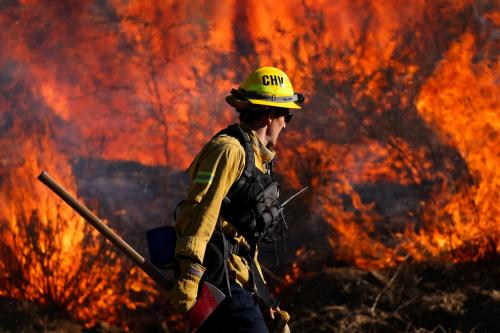Among the legacies Saddam Hussein will leave any successor are the one million or more persons who today remain forcibly displaced within the borders of Iraq, the human toll of his regime’s decades long drive to subdue recalcitrant populations, take over oil rich and fertile land, and stamp out political opposition. As a result of deliberate state policies of expulsion, an estimated 600,000 to 800,000 persons are displaced in the north of the country and an estimated 300,000 in the center/south.
The main victims are the Kurds—Iraq’s largest minority—and members of the Shi’ite majority, particularly the Marsh Arabs and Shi’ite opponents of the regime. However, the regime has also targeted the smaller Turkmen and Assyrian (Christian) minorities. As such, the internally displaced represent the major political fault lines of the country.
The plight of Iraq’s internally displaced is bound up with issues of water, land, oil, minority and majority rights, ethnicity and religion, citizenship and national allegiance, and systems of justice. Any new government will have to address these issues as a high priority if it is to secure the unity and stability of Iraq. But this will not be easy. It will require the return or resettlement of hundreds of thousands of displaced people, in many cases to areas already occupied by others or that have been destroyed, as well as resolving different ethnic groups’ competing claims to resources and land and the meting out of justice through trials, legal redress or economic compensation.
THE GREATEST PROBLEMS LIE IN THE NORTH
Of the groups affected, the Kurds have been the most brutally treated. Successive Iraqi regimes have repeatedly denied their demands for political autonomy, suspecting this could lead to Kurdish independence, and have responded to Kurdish rebellions with overwhelming force. Beginning in the late 1970s, Saddam Hussein’s government forcibly displaced hundreds of thousands of Kurds, destroyed some 4,000 of their villages, sprayed more than 200 of these with chemical weapons, and carried out mass killings with genocidal intent. As a result, of the 668,000 Kurds displaced in the north, most cannot now return to their original homes owing to the Iraqi security forces continued occupation of their lands, the widespread destruction of their villages and the planting of landmines (3,400 mined areas over some 900 square kilometers).
Any solution for this group will require a vastly changed political system, one that involves a pluralistic political structure. Over the past decade, a Kurdish Regional Government has been functioning, albeit unevenly, in the north under the security guarantee of the United States. A responsible successor Iraqi government could work with the Kurdish authorities to begin systematic de-mining efforts, rebuild the countryside to enable returns, and resettle the displaced in cities. Such steps will require the cooperation of the two main Kurdish political groupings, Masud Barzani’s Kurdish Democratic Party and Jalal Talabani’s Patriotic Union of Kurdistan. Fighting among these and other Kurdish factions from 1994 to 1997 forcibly uprooted more than 100,000 people. Despite a US brokered truce, most have still not felt secure enough to return home.
It will be equally challenging to help the more than 100,000 Kurds, Turkmen and Assyrians expelled from Kirkuk and its surrounding region as a result of the government’s “Arabization” campaign. Successive Iraqi regimes have sought to bring Arabs from various parts of Iraq to this area rich in oil and fertile land. Although many deeds, cadasters and other documentation have been deliberately destroyed, according to the 1957 census—the last one on which there is general agreement—the plurality of the population in the city of Kirkuk was Turkmen, and the majority of the population in the region was Kurdish. Mostly through bureaucratic means, which continue today, the government undertook to force out non-Arabs by prohibiting them from purchasing property, renewing their work permits or enrolling their children in school, and by dismissing non-Arabs employed in the oil fields.
Should there be a change of regime in Iraq, Kurdish leaders have vowed to reestablish control over the Kirkuk region, while Turkmen look to Turkey to reinstate their interests there. Arabs now established in the area will no doubt seek to retain their monopoly. To the broad conflict over which national group should prevail in Kirkuk and its environs will be added well nigh intractable disputes over individual property rights.
Although the IDP problem in southern Iraq is neither as large or complicated as that in northern Iraq, it too will need to be addressed by any Iraqi successor regime. In the areas under the regime’s control, there are another estimated 300,000 displaced persons. Nearly 100,000 people remain displaced in Basra and other cities from the time of the Iraq/Iran war and following Iraq’s defeat in the Gulf War. Another 200,000 were also displaced by the government’s deliberate destruction of the habitat of the Marsh Arabs along the lower Tigris and Euphrates rivers. Baghdad coupled massive hydrological engineering projects to drain water from the marshes with the shelling and burning of marsh villages, the poisoning of fishing grounds, and the assassination and abduction of local leaders, all in an effort to eliminate a population outside the regime’s control and a sanctuary for armed Shi’ite opposition. It also enabled the regime to better exploit the substantial oil reserves beneath the marshes. From an estimated original Marsh Arab population of 400,000, the inhabitants of Iraq’s few remaining marshes have been reduced to a reported twenty to forty thousand persons today.
ADDRESSING THE PROBLEMS
A recent study published by the Brookings-SAIS Project on Internal Displacement (John Fawcett and Victor Tanner, “The Internally Displaced People of Iraq,” Occasional Paper, Brookings-SAIS Project on Internal Displacement, October 2002) recommends a series of steps to manage the problem. First, acknowledge that the expulsion of people from their homes on ethnic grounds constitutes a crime and that those expelled have a right to restitution. Second, set up an official body with representative ethnic and religious makeup and international oversight to enable persons to regain land and property lost as a result of displacement. Third, establish a special task force to coordinate returns and adjudicate disputes, thereby preempting a rush on Kirkuk and other cities. Fourth, apportion oil revenues to compensate those expelled from the Kirkuk area and arbitrarily dismissed from their positions in the oil fields.
Repairing the damage to Iraq’s Marsh Arab population will require special efforts. It would be technically, ecologically and politically difficult to recreate the marshes as they originally were, especially now that oil has been discovered beneath the surface. Nevertheless, there are steps that could be taken to address the needs of those forcibly displaced. To begin with, consultations should be held with the former inhabitants of the marshes and a feasibility study done to see whether at least some of the marshes could be re-flooded. For those who cannot return, at the very least a compensation scheme from the oil revenues should be devised.
Helping Iraq to solve the problem of its internally displaced persons will also require changes in the UN response, which has so far proven inadequate. The United Nations is the main provider of humanitarian assistance to Iraq but has given insufficient attention to assisting or protecting the displaced to date. The Oil-for-Food Program generates as much as $6 billion a year for Iraqi civilian spending, more than enough to fund programs for the displaced. Yet according to a UN survey in 2000, more than 400,000 displaced persons in the north live in collective towns, many in an advanced state of decay. A further 57,000 live in barracks, including more than 6,000 still in tents. More than 50,000 in the north are without access to health centers. In the center/south, governmental obstruction has been reported when the displaced register for food rations and little is known about their numbers or conditions.
According to the Brookings-SAIS study, this state of affairs is mainly attributable to Iraqi government intimidation combined with a self-imposed “code of silence” practiced by UN officials. Fearing violence, expulsion or other retaliation from Iraq and lack of backup from UN headquarters, UN officials in most cases have refrained from demanding access to the displaced or protesting their treatment, especially in the center/south.
More than $35 billion has thus far been allocated to providing supplies under the Oil-for-Food program and more than $25 billion in goods has actually been delivered to Iraq. Given these overall levels, it is reasonable to expect the UN to make more targeted use of the Oil-for-Food funds to help the displaced, one of the most vulnerable segments of the Iraqi population. The UN should insist upon access, publish data on their conditions, publicize instances where displaced persons cannot secure food rations because of the government’s complicated registration system, and promote better shelter and health care for those in serious need. The Iraqi government derives considerable advantage from the Oil-for-Food Program and the UN could extract a far higher price for the benefits which the government receives. An independent evaluation of how the Oil-for-Food funds are being used, especially with regard to the displaced, would be valuable. So too would a visit by the Representative of the UN Secretary-General on Internally Displaced Persons to assess conditions on the ground.
It is not too early to begin to address problems of internal displacement in Iraq. In a country of 23 million, Iraq’s more than one million internally displaced persons constitute too large a group to be ignored, and the linkage between their plight and Iraq’s deeper political, economic, ethnic, and social problems suggests that to try to ignore them could undermine any reconstruction effort in fundamental ways.



